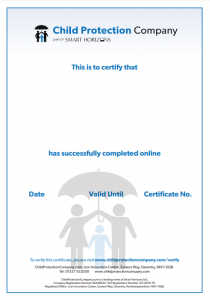Safeguarding Children
Please read our level 1/2 safeguarding training article especially if you are a healthcare professional
Our Safeguarding Children course provides online safeguarding training for anyone who comes into contact with children and young people during work, voluntary or leisure activities, including topics such as key legislation, how to report concerns, and indicators of abuse and neglect.
If you work in healthcare, please read the 'What is level 1/2 safeguarding training' article which offers more explanation on the safeguarding training levels in the sector.


£25.00 + VAT
Bulk Buy Discounts
10+ courses - Save 10%
20+ courses - Save 15%
50+ courses - Save 20%
75+ courses - Save 25%
100+ courses - Save 30%
Volume discount applied at checkout
Key Features

Safeguarding Children Course Content
This course is a basic introduction to safeguarding and child protection that will help you to recognise potential abuse and provide you with the knowledge to report the incident and take appropriate action.
There is a specific version of the course for England, Scotland and Wales.
On completion of this course, the learner will:
- Have an awareness of the range of legislation and guidance surrounding safeguarding and the protection of children in England, Scotland and Wales
- Be able to define the different types of child abuse
- Be able to demonstrate an awareness of the range of indicators of abuse and neglect
- Be aware of the effects of personal values and attitudes towards abuse
- Understand their responsibility to report concerns
- Be aware of the importance of maintaining a child focus
- Be able to demonstrate an awareness of the actions to take in the event of suspected abuse
The purpose of this first module is to help you to assess your current knowledge of child protection. You will look at a series of scenarios that will start you thinking about some of the ways in which you could encounter potential abuse in your working day and what actions you might take in response.
This module will look at what child protection and safeguarding actually mean. On completion of the module, you will have a much better understanding of key words and phrases and how these relate to safeguarding and protecting children. A better understanding of what terms such as ‘child in need’ and ‘significant harm’ mean will help you to put the language of child protection in context.
Safeguarding and protecting children and young people must operate within a framework of guidance and legal procedure. This module offers an overview of this framework and how it is applied. Of course, you will not be expected to suddenly be able to quote detailed laws directly, but you will gather a general understanding of what they are. This module will also look at the organisations that play a part in safeguarding, their responsibilities and the guidelines for protection.
By the end of the module, you will have a much clearer understanding of safeguarding guidance, the associated agencies and the legalities of protection. You will also see how the agencies work together to tackle the problem of abuse. Based on your initial selection, this module will take into account the regional-specific legislation for child protection training in England, Scotland, Wales and Northern Ireland.
To effectively detect, reduce and hopefully prevent child abuse, we need to strictly define what it is and how it manifests itself. Understanding the categories of abuse allows us look for the tell-tale signs that it is taking place.
At the end of this module, you will have a better understanding of what we mean by child abuse and what the specific areas of abuse are.
Children and young people often find it very difficult to talk about the abuse they're experiencing. The anxiety they feel may manifest in different ways, such as displaying challenging or changed behaviours, and we need to recognise these signs of abuse. Abusers are often adept at covering their tracks and may appear to be very caring people, so recognising the signs of abuse can often be the first alert of a situation.
At the end of this module, you will be more familiar with the definitions of abuse and the signs and indicators of the different types of abuse.
The focus of safeguarding and responding to any potential abuse must be the safety of the child or young person. Remaining child-centred is vital to the process of identification and reporting, because sadly, children sometimes report several times before any action is taken. This module utilises a realistic scenario to contextualise a child-focused approach.
By the end of this module, you will have a better understanding of what it means to be child-focused and how this can be achieved.
This part of the course builds on the work we did in module three, where we looked at effective consultation between agencies and the increased understanding of the signs and different types of abuse we discussed in modules four and five. Children can disclose in a number of ways, so, while you want to maintain confidentiality where appropriate, you also need to know when to report and to whom. It is vital that you respond quickly and appropriately when presented with a disclosure of abuse, and this module will cover the right process to follow and what to do (and what not to do) to achieve the desired outcome.
By the end of this module, you will have a better understanding of the correct procedures to follow in response to a potential abuse situation, and will know what to do if you have concerns about the behaviour of an adult. A step-by-step guide is included, which will help you to refer any concerns you may have.
Using a range of appropriate scenarios, you will now take all that you have learned and apply it to an assessment of your knowledge. The final module will allow you to show how much you have absorbed and why it is so important to have child protection training.
Once you have passed your assessment, you will be able to download your certificate. Your pass rate will be 70% but don’t worry if you do not pass the first time, as you can take the test multiple times.
This section contains a range of useful sources of information, downloadable materials, further reading and resources that you may find useful.
Schools Trust Us
"As a teacher who is very concerned about the welfare of children, this course has enlightened me and broadened my understanding of what to do if ever there was any form of abuse, be it among children themselves or members of staff."
Tobias Chiwereza, T for Teachers
"This was a very clear course, with well laid-out sections enabling the user to pause and come back at any point. The end of section quizzes help cement the knowledge acquired in each section."
Sinead McCurry, Somerhill
Benefits
- Instant access to courses
- Training can be taken any time – no need for staff to even be on site
- Takes between 1-2 hours to complete
- Courses can be taken 24/7 online or on mobile devices
- Less expensive than face-to-face training
- No need to take time out of work to undertake training
- No requirements for minimum or maximum group sizes
- Retrieve centrally held online certificates at the touch of a button
- Individual, personalised certificates can be downloaded and printed
- Automated reminders when training is due for renewal
- Courses can be stopped and restarted at any point
- Course notes and resources available for the duration of certification
- Downloadable Excel reports so you can monitor completion
- Friendly, UK-based customer support centre in case you have any queries
- Regularly updated to meet legislation changes
- Regional variants available for England, Scotland, Wales and Northern Ireland
- Provides information, scenarios and downloads relevant to a range of different sectors
Education Customers - Save Money with our Safeguarding Education Training Bundle
Mix and match these courses:
With refresher courses available
Or call our Customer Support team on 01327 552030 to discuss your specific requirements
Safeguarding Children FAQ
No, this course does not include vulnerable adults safeguarding training. If you work with both children and adults at risk, our Safeguarding Children and Vulnerable Adults online course is the course you will need to take.
Yes, this safeguarding course offers a general introduction to safeguarding and is suitable for anybody who comes into contact with children and young people during work, voluntary or leisure activities.
Why use our Learning Management System

Call us today at 01327 552030!
Or, alternatively:
